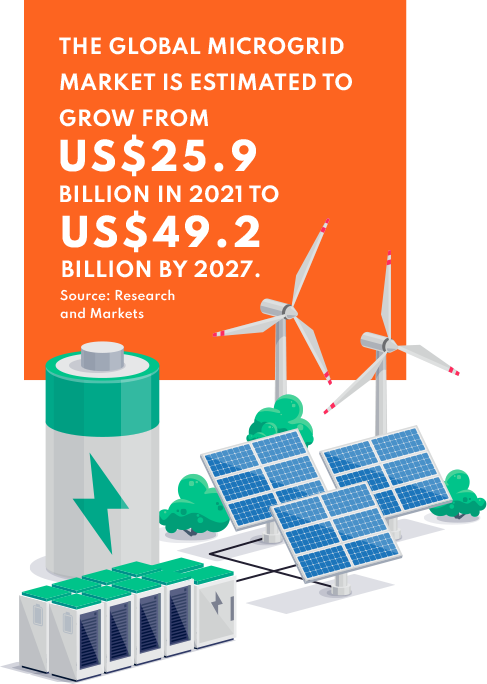KEEPING
SUSTAINABILITY
AT THE FOREFRONT
Powering the green revolution for the low-carbon transition
change
for a . more prosperous future
 rom wildfires to
flash floods, natural disasters appear to be getting worse with each passing year. And
the worst is yet to come, based on the latest
Intergovernmental Panel on Climate Change (IPCC) report released in February
2022. Over 40 per cent of the world’s population — more than 3 billion people — live in
environments highly vulnerable to climate change. Coastal cities and settlements, like
Singapore, are at risk of rising sea levels which would have a devastating impact on
communities and infrastructures. The window of opportunity to secure a liveable and
sustainable future for all is narrowing quickly.
rom wildfires to
flash floods, natural disasters appear to be getting worse with each passing year. And
the worst is yet to come, based on the latest
Intergovernmental Panel on Climate Change (IPCC) report released in February
2022. Over 40 per cent of the world’s population — more than 3 billion people — live in
environments highly vulnerable to climate change. Coastal cities and settlements, like
Singapore, are at risk of rising sea levels which would have a devastating impact on
communities and infrastructures. The window of opportunity to secure a liveable and
sustainable future for all is narrowing quickly.
To address this climate emergency, governments, businesses and individuals need to take
urgent action using sustainable and innovative solutions. Doing its part to accelerate
change, Temasek has placed sustainability at the core of everything it does. The investor
has pledged to halve the net carbon emissions of its portfolio from 2010 levels by 2030,
and to achieve net-zero carbon emissions by 2050. It does so through a three-pronged
approach — investing in climate-aligned opportunities across key sectors, reducing
emissions through carbon-negative solutions, and encouraging decarbonisation efforts
among its portfolio companies.
Temasek has been investing in climate-aligned opportunities. It has partnered global
investment company BlackRock to set up Decarbonization Partners, which will launch a series
of venture-capital and private-equity investment funds to advance proven, next-generation
technologies that can reduce or eliminate carbon emissions. At the same time, directly
reducing carbon emissions by enabling carbon-negative solutions is essential to building a
sustainable future. On this front, Temasek, together with DBS Bank, Singapore Exchange and
Standard Chartered, jointly established Climate Impact X, a global carbon exchange and
marketplace for high-quality carbon credits to help institutions address unavoidable carbon
emissions in the near term and complement broader decarbonisation efforts.
Temasek is also actively supporting its portfolio companies as they make the journey from
brown to green. Over the years, it has advanced dialogues with companies on their climate
strategies and emissions reduction plans, and continues to work closely with them to
implement and execute sustainable solutions. It also backs start-ups with innovative,
disruptive decarbonisation technologies that show promising potential for scalability.
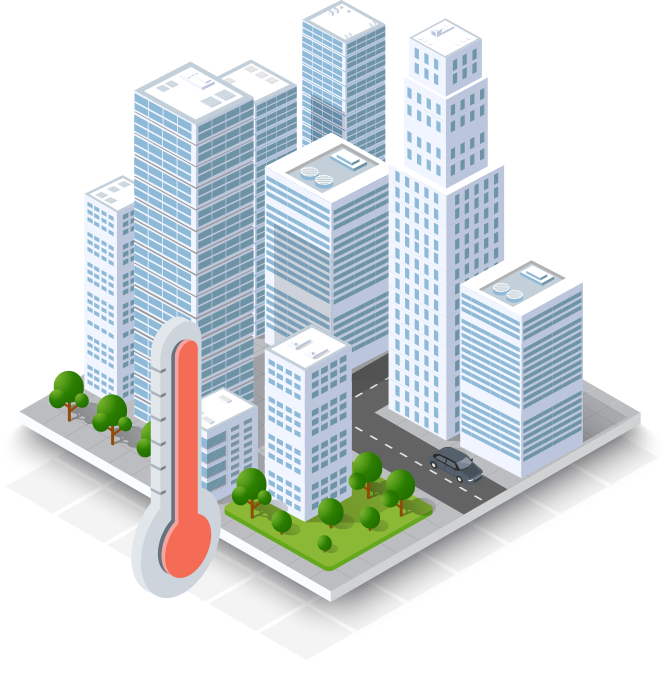
TAKE A QUIZ

IN IT FOR THE
LONG HAUL
Climate change is the existential challenge of our time. Our purpose as an intergenerational investor is to ensure that every generation prospers. Addressing climate change through achieving net zero is therefore critical to our purpose. At Temasek, we deploy catalytic capital to accelerate the development and deployment of sustainable solutions. These solutions cover seven main areas — waste, water, food, energy, clean transport, materials and built environment — sectors where capital can make a real impact. Sustainable living and climate change mitigation are core parts of the future that we seek to build as an investor.
CIX and Decarbonization Partners represent two important aspects of our approach to help industries decarbonise. Next-generation solutions take time to mature and scale. Yet, short-term action is also needed to address climate change. Credits from nature-based projects, in particular, provide cost-effective and at-scale solutions.
CIX and Decarbonization Partners act as catalysts or a nexus to build an ecosystem around these solution sets. For example, Decarbonization Partners already has US$600 million (S$833 million) in initial combined capital from Temasek and BlackRock, and will soon launch its first fund with a target size of US$1 billion. In March 2022, CIX launched Project Marketplace, a digital platform for businesses and carbon project suppliers to list, discover, compare, buy and retire high-quality carbon credits. CIX’s Auction and Spot Exchange platforms will be launched later. It will also work with partners to improve the monitoring, reporting and verification of projects, as well as provide ratings and other ecosystem services to scale the carbon markets.
Carbon credits do not just offset our existing carbon footprint. The carbon credits market provides a channel to redirect financial resources to offset the cost premium with new tech solutions. This will allow us to lower costs, stimulate demand and accelerate the deployment of solutions that can fundamentally decarbonise industries.
We recognise that efforts to introduce decarbonisation solutions have long lead times, involve heavy capital investments over years to achieve scale and require carefully calculated risks to avoid missteps. As a long-term investor, we are able to put patient capital behind start-ups with innovative decarbonisation technologies that have shown promising potential.
Besides providing capital, Temasek can leverage our ecosystem of operating companies, our Foundation and other network partners to co-develop new solutions.
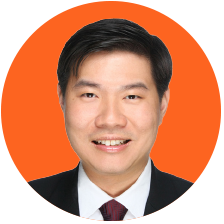
MR FREDERICK TEO
SUSTAINABLE SOLUTIONS,
TEMASEK
SUSTAINABLE SOLUTIONS,
TEMASEK

“Our purpose as an intergenerational investor is to ensure that every generation prospers. Addressing climate change through achieving net zero is therefore critical to our purpose.”
“Our purpose as an intergenerational investor is to ensure that every generation prospers. Addressing climate change through achieving net zero is therefore critical to our purpose.”
— MR FREDERICK TEO


A ‘COOL’
SOLUTION
For decades, SP Group has served as Singapore’s reliable and efficient
national grid operator, supplying electricity to over 1.6 million customers. Its push
towards encouraging customers to save energy, through the provision of energy-efficient
solutions, is relatively recent. “In the last five or six years, we’ve been paying more
attention to enabling customers on their sustainability journey. Our goal is to empower
the future of energy with low-carbon, smart energy solutions,” said Mr S. Harsha,
Managing Director of Sustainable Energy Solutions at SP Group.
Customer-centric sustainable solutions range from rooftop solar systems and electric
vehicle charging points to the SP Utilities app, which allows households to track and
manage energy consumption. SP is also partnering Temasek to pilot a novel solution
called Distributed District Cooling (DDC), an extension of SP’s renowned district
cooling system in Marina Bay.
By centralising the production of chilled water for air-conditioning needs and
leveraging economies of scale, SP’s commercial customers in Marina Bay have
significantly reduced their energy consumption and carbon emissions. It also allows them
to benefit from reductions in equipment capacity and space requirements, as well as
savings in maintenance and repair costs.
HOW DOES
DISTRICT
COOLING WORK?
HOW DOES
DISTRICT COOLING WORK?
Chilled water is produced in a central cooling plant.
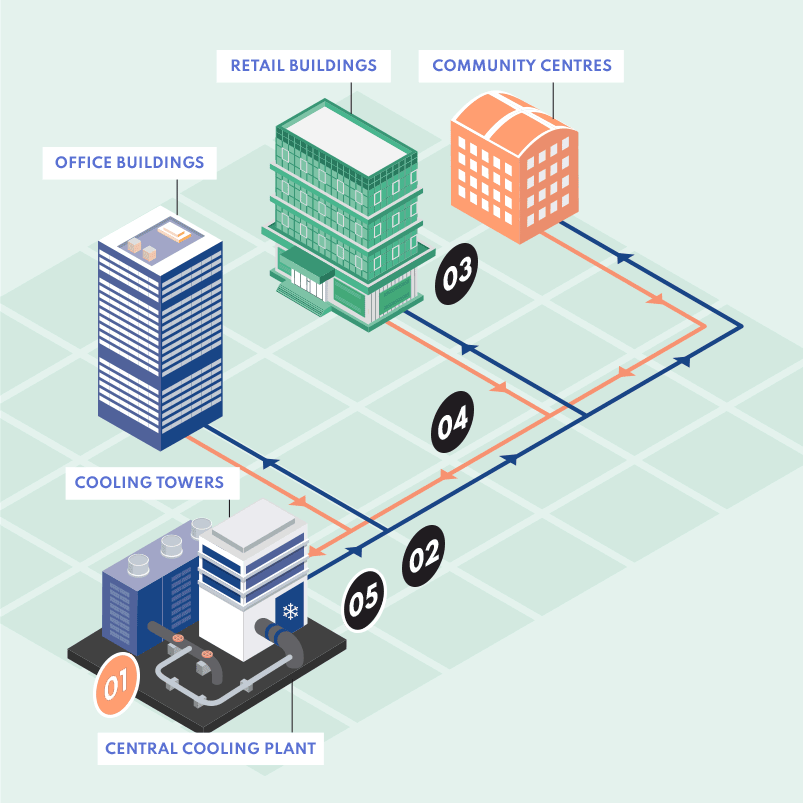
HOW DOES
DISTRICT
COOLING WORK?
HOW DOES
DISTRICT COOLING WORK?
A closed-loop network of underground insulated pipes distributes chilled water to each customer’s building.
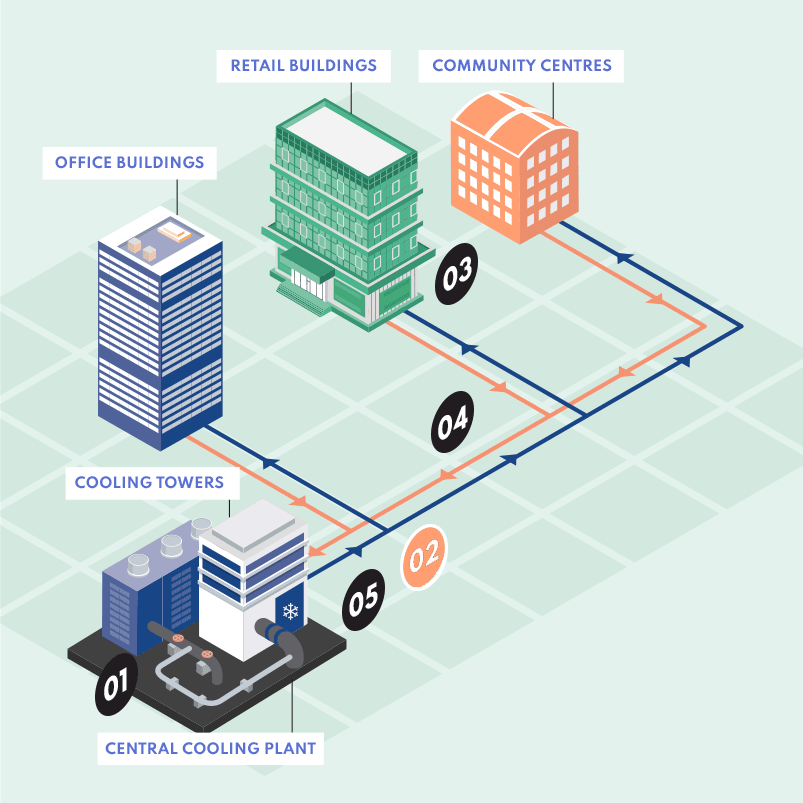
HOW DOES
DISTRICT
COOLING WORK?
HOW DOES
DISTRICT COOLING WORK?
Energy transfer stations within each building circulate chilled water from the network into the building’s air-conditioning system.
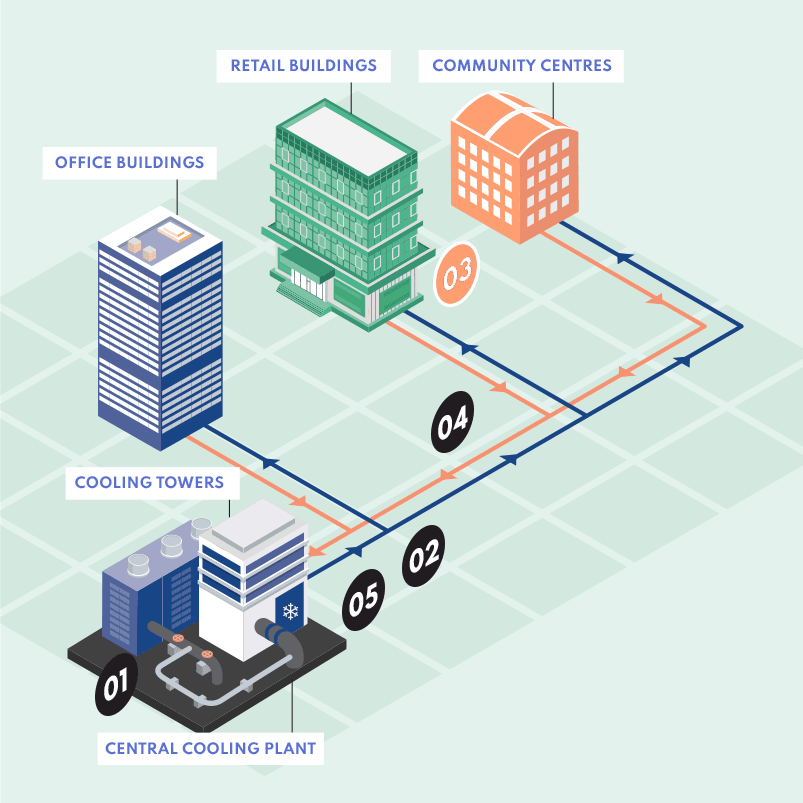
HOW DOES
DISTRICT
COOLING WORK?
HOW DOES
DISTRICT COOLING WORK?
Warm water is circulated back to the cooling plant, via return pipes, to be chilled again. The process then repeats.
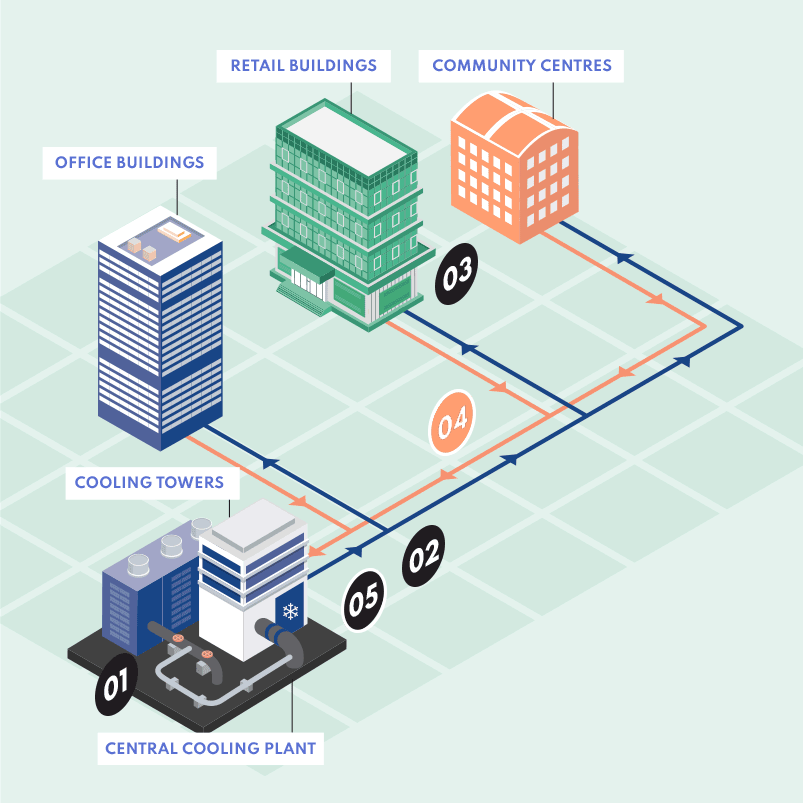
HOW DOES
DISTRICT
COOLING WORK?
HOW DOES
DISTRICT COOLING WORK?
Thermal storage tanks (if used) store cold energy to regulate cooling demand and provide resilience.
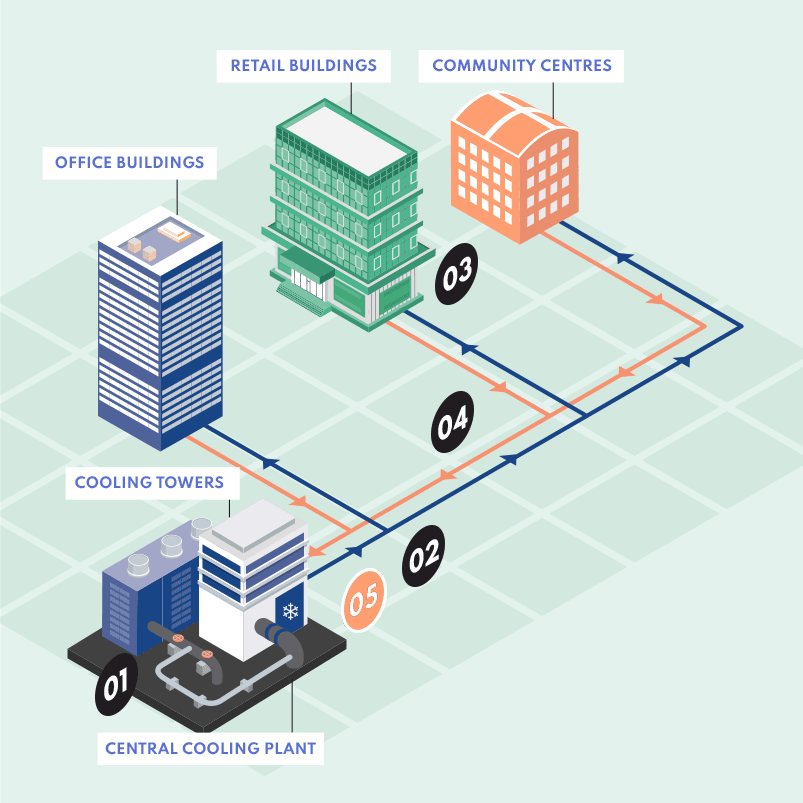
Where DDC differs from the Marina Bay system is that the latter is a greenfield project: It
was developed from scratch on a vacant site, which meant centralised cooling could be
integrated into its design from the start. However, most of Singapore’s land has been built
up, with buildings that already have their own chiller plants. “To address this brownfield
segment, we conceptualised a DDC network where existing buildings with excess chiller
capacity and very good energy efficiencies could act as injection nodes, supplying chilled
water to meet its own cooling demands as well as those of other buildings — or off-takers —
via underground pipes,” Mr Harsha explained.
To test this concept, SP conducted a feasibility study for a proposed DDC network of 14
buildings in Tampines Central in 2020. These included commercial and public office
buildings, retail malls, data centres and a community hub. Injection nodes and off-takers
were identified, and technical drawings were drafted to show how pipes could be laid below
ground to connect them. It was found that in one year, building owners could achieve 17 per
cent energy savings, reduce carbon emissions by 18 per cent, and earn S$4.3 million in
economic value from cost savings as well as new revenue streams owing to the freed-up
chiller plant space.
Mr Harsha noted that Temasek was a big reason the study got off the ground in the first
place: “We had to convince building owners to come on board the journey and also engage
with relevant government agencies, such as the Ministry of Sustainability and the
Environment. Temasek, with its wide network of partners, linked us up with senior
stakeholders within these organisations. We may have the domain expertise to take on this
project, but it would be extremely difficult to pull off on our own.”
Thanks to the SP-Temasek pilot trial, DDC is moving from concept to reality. On April 18,
2022, SP signed supply agreements with six building owners that collectively own seven
buildings. Next comes the actual construction work. “Hopefully, by 2025, we will finish
Phase 1, and the first-of-its-kind DDC network in Singapore will be up and running in
Tampines Central,” said Mr Harsha. “I think we’ll get to a stage one day where DDC will be a
viable option for other brownfield precincts. This would contribute not just to Super Low
Energy (SLE) buildings but to an SLE Singapore, and a low-carbon future for everybody.”

Goal 7


GOING
OFF-GRID
In the world’s second-most populous nation, Temasek is also exploring ways to scale
clean energy infrastructure. In December 2021, it joined forces with Schneider Electric,
a global specialist in energy management and automation, to launch GREENext in India. This joint venture will provide sustainable
and resilient energy solutions to commercial and industrial customers across India, in
the form of microgrids powered by renewable energy.
A microgrid is a decentralised, local energy grid that is usually connected to the main
utility grid, but it can operate independently using small-scale power generation
sources located on-site. On one hand, microgrids can function in disconnected ‘island’
mode, providing back-up during power outages or when electricity prices spike. On the
other hand, the smaller units — also called distributed energy resources — are often
made up of renewable energy sources such as rooftop solar panels, wind turbines and
electric vehicle chargers, thus making microgrids more environmentally-friendly than the
traditional grid.
“Microgrids provide efficient, low-cost, clean energy; enhance local resiliency; and
improve the operation and stability of the regional power grid. They provide dynamic
responsiveness unprecedented for an energy resource,” said Ms Damini Chaudhari, Head of
GREENext. Its microgrid technology, pre-engineered and standardised to increase
deployment speed, uses a combination of solar power and digitally optimised batteries to
store power, providing an additional layer of reliability.
look over the horizon
Temasek seeds catalytic capital
to make a difference with tomorrow in mind















